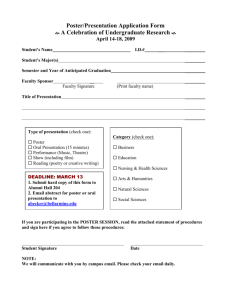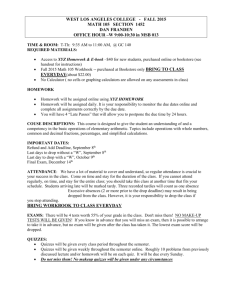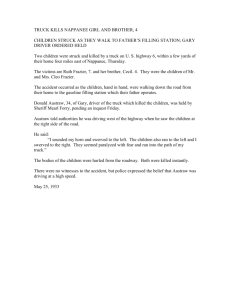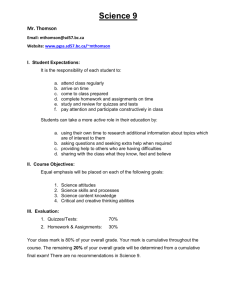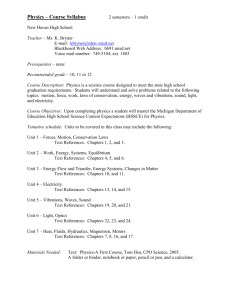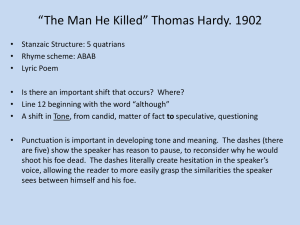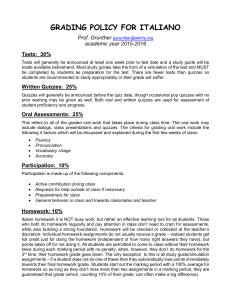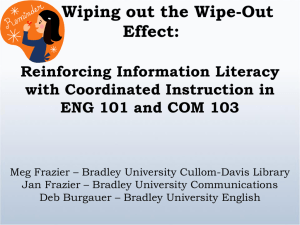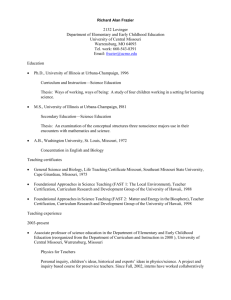AP United States History
advertisement
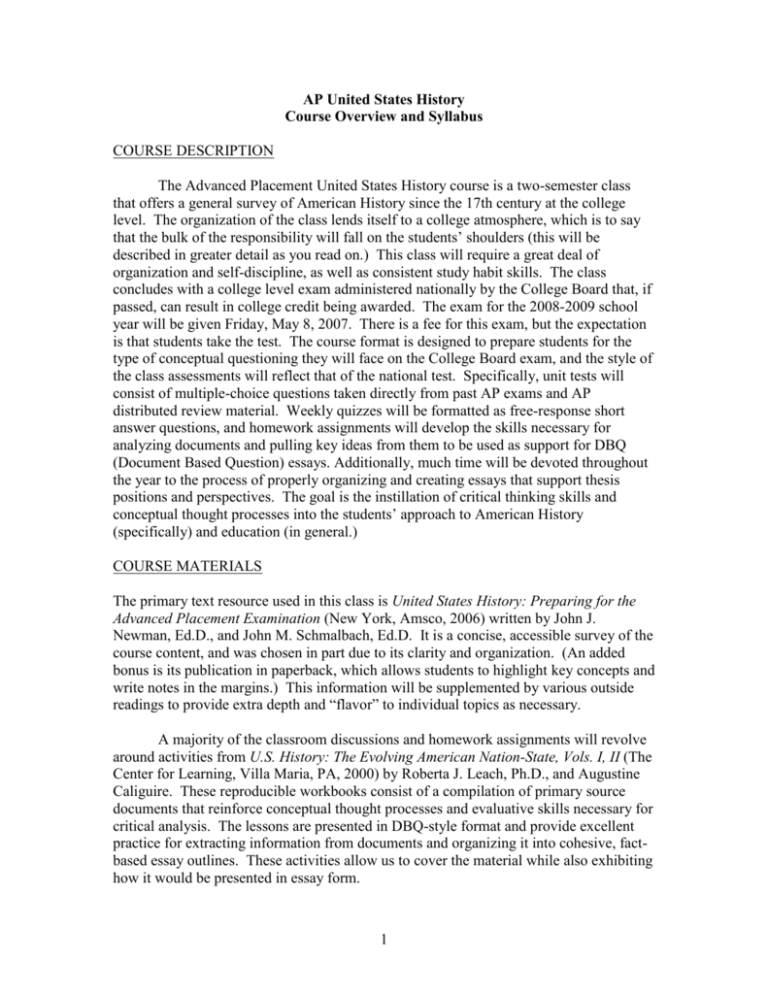
AP United States History Course Overview and Syllabus COURSE DESCRIPTION The Advanced Placement United States History course is a two-semester class that offers a general survey of American History since the 17th century at the college level. The organization of the class lends itself to a college atmosphere, which is to say that the bulk of the responsibility will fall on the students’ shoulders (this will be described in greater detail as you read on.) This class will require a great deal of organization and self-discipline, as well as consistent study habit skills. The class concludes with a college level exam administered nationally by the College Board that, if passed, can result in college credit being awarded. The exam for the 2008-2009 school year will be given Friday, May 8, 2007. There is a fee for this exam, but the expectation is that students take the test. The course format is designed to prepare students for the type of conceptual questioning they will face on the College Board exam, and the style of the class assessments will reflect that of the national test. Specifically, unit tests will consist of multiple-choice questions taken directly from past AP exams and AP distributed review material. Weekly quizzes will be formatted as free-response short answer questions, and homework assignments will develop the skills necessary for analyzing documents and pulling key ideas from them to be used as support for DBQ (Document Based Question) essays. Additionally, much time will be devoted throughout the year to the process of properly organizing and creating essays that support thesis positions and perspectives. The goal is the instillation of critical thinking skills and conceptual thought processes into the students’ approach to American History (specifically) and education (in general.) COURSE MATERIALS The primary text resource used in this class is United States History: Preparing for the Advanced Placement Examination (New York, Amsco, 2006) written by John J. Newman, Ed.D., and John M. Schmalbach, Ed.D. It is a concise, accessible survey of the course content, and was chosen in part due to its clarity and organization. (An added bonus is its publication in paperback, which allows students to highlight key concepts and write notes in the margins.) This information will be supplemented by various outside readings to provide extra depth and “flavor” to individual topics as necessary. A majority of the classroom discussions and homework assignments will revolve around activities from U.S. History: The Evolving American Nation-State, Vols. I, II (The Center for Learning, Villa Maria, PA, 2000) by Roberta J. Leach, Ph.D., and Augustine Caliguire. These reproducible workbooks consist of a compilation of primary source documents that reinforce conceptual thought processes and evaluative skills necessary for critical analysis. The lessons are presented in DBQ-style format and provide excellent practice for extracting information from documents and organizing it into cohesive, factbased essay outlines. These activities allow us to cover the material while also exhibiting how it would be presented in essay form. 1 Other works that are consulted and/or employed periodically over the span of the course are listed below, although it is by no means definitive: George Brown Tindall, David E. Shi, America: A Narrative History (New York, W.W. Norton and Co., 1996) volumes one and two. Thomas R. Frazier, Voices of America: Readings in American History (Boston, Houghton Mifflin, 1985) Theodore J. Morse, Excellence in U.S. History: Preparing for Advanced Placement (New York, Longman, 1986) Michael Henry, Ph.D., Threads of History: A Thematic Approach to Our Nation’s Story (The Peoples Publishing Group, NJ, 2006) *Students will also be required to keep a notebook containing all notes, readings, graphic organizers, maps, etc. distributed during the course of the year. This will be graded twice per quarter and is designed to be a review tool for the national exam in May. MAJOR THEMES OF THE COURSE The following are recurrent themes that can be found throughout the course of our study of American History. Lessons will be structured around these important concepts: 1. 2. 3. 4. 5. 6. The Creation of an American Identity The Evolution of Democracy The Development of the Nation-State America’s Position in the World Community The Evolution of Free-Market Capitalism Diversity in the United States CURRICULUM CALENDAR Unit 1: Colonial History to 1763 This unit is assigned over the summer and is designed to provide a background to the coming of the American Revolution. Tasks for this unit include: Reading chapters 1-4 in the Newman text and reviewing the typed, outline notes that accompany them (included in Summer Assignment Packet) Completion of lessons 1-3, 5 in Leach workbook ( Summer Assignment Packet) - Lesson1: The Three Colonial Sections- One Society or Three? - Lesson 2: From Authority to Individualism - Lesson 3: Colonial Exploitation- A Matter of Perception - Lesson 5: British Colonial Policy- A History of Neglect 2 Completion of the Colonial Organization Chart (Summer Assignment Packet) Completion of the Chapter quizzes (Summer Assignment Packet) The first 1-2 weeks of class will be spent reviewing these assignments and identifying evidence of the evolution of democracy and the development of an American identity. These assignments will provide students with practice using such critical thinking skills as interpreting documents, drawing inferences, assuming perspectives, gleaning information from documents to support a thesis, and preparing concise summaries. Our first multiple-choice test concludes this unit. Unit 2: Period of Tension, Revolution, and the New Republic (1763-1800) Required Reading: chapters 5-6 in Newman text, “George III States The British Goal” (Frazier), “Common Sense” by Thomas Paine (Frazier), Washington’s Farewell Address (Sept. 1796), “The First Democrats,” US News and World Report (Aug. 21, 2000) Lessons 7-9, 11, in Leach workbook - Lesson 7: Path to Revolution, 1763-1776 - Lesson 8: Dec. of Independence - Lesson 9: Jameson; The Revolution as a Social Movement - Lesson 11: The Constitution- Balancing Competing Interests Class Presentation Projects: The Development of Political Parties (lesson 13, Leach) - Hamiltonian v. Jeffersonian political ideology (Debate) Writing Assignment: Essay organization using the prompt, “To what extent did Hamilton and Jefferson disagree on the powers and policies of the New Federal Government?” Key Discussion topics: Salutary Neglect, British response to colonial resistance, war overview, results of the Revolution Assessments: Weekly quizzes, Unit test (M/C) Unit 3: Age of Jefferson, War of 1812, and the Rise of Nationalism (1800-1828) Required Reading: Chapters 7-9 in Newman text, “Thomas Jefferson’s View of the Courts” (Frazier), “The Prospect Before Us” (Frazier) Lessons 14-15 in Leach workbook - Lesson 14: The Role of the Judiciary in Creating the Nation-State - Lesson 15: Nationalism Ascendant 3 Writing Assignment: essay organization for the prompt, “Assess the importance of the Federalist Party to the development of the Federal Government." War Summary Chart Key Discussion Topics: John Marshall’s Supreme Court, Constitutionality of the Louisiana Purchase, The War of 1812 as the conclusion of the Revolution, Death of the Federalists, “The Era of Good Feelings,” The Monroe Doctrine, “The Corrupt Bargain,” Elections of 1824, 1828. Assessments: Weekly quizzes, Unit test (M/C) Unit 4: The Age of Jackson, Early Reform, and Westward Expansion (1828-1850)) Required Reading: chapters 10-12 in Newman text, “Andrew Jackson Defends Rotation in Office” (Frazier), “John Calhoun on Nullification” (Frazier), “Philip Hone Welcomes a Change” (Frazier), Resistance to Civil Government, H.D. Thoreau (1849), “Annexation,” John L. O’Sullivan, The United Sates Magazine and Democratic Review (July-August, 1845), “Opposition to Expansion” (Frazier) Lessons 18, 20-21 in Leach workbook - Lesson 18: The Evolution of Democracy from Jefferson to Jackson - Lesson 20: The Mexican War- Was it in the National Interest? - Lesson 21: Westward Expansion- A Force for Unity or Division? Reformer Chart, chapter 11 Map, chapter 12 War Summary Chart Key Discussion Topics: Return to a Two-Party System, Tariff Controversy, Expansion of Popular Involvement in Government, Transcendental Thought as it Applied to Social Change, Manifest Destiny, Problems With Expansion. Assessments: Weekly quizzes, Unit test (M/C) Unit 5: Antebellum Period, Civil War, and Reconstruction (1850-1877) Required Reading: chapters 13-15 in Newman text, The Real Lincoln, Thomas Dilorenzo, (excerpt), “General Grant’s Report on the South, 1865” (Frazier), “A White Southerner Views Reconstruction” (Frazier), “Violence in the Senate Chamber” (Frazier) Lesson 23 in Leach workbook - Abolition- The Role of the Individual in Effecting Change 4 Class Project: The Impeachment of Andrew Johnson (mock trial) War Summary Chart Key Discussion Topics: Slavery as the Organizing Principle of Southern Culture, Attempts at Compromise, Comparisons of Northern and Southern Economies, State-Compact Theory, War Overview, Lincoln’s Assassination, Abandonment of Civil Rights Protection for the Freedmen. Assessments: Weekly quizzes, Unit test (M/C) Unit 6: The Gilded Age (1877-1900) Required Reading: chapters 16-19 in Newman text, “Josiah Strong on Cities” (Frazier) Lessons 25, 27, 28, 32, 33 in Leach workbook - Lesson 25: The Emergence of Industrial America - Lesson 27: National Govt. in the Late 19th Century- A Sham of Democracy - Lesson 28: The Philosophy of the Industrialists - Lesson 32: The Populist Movement- The Value of Third Parties - Lesson 33: Divergent Paths to Black Equality Movie Excerpt: Far and Away (1992) Writing Assignment: Peer-Evaluation Essay written using the prompt “Identify the social, economic, and political factors that contributed to the development of American society in the late 19th century.” Key Discussion Topics: Immigration, Industrialization, Urbanization, Laissez-faire Capitalism, Social Darwinism, The Gospel of Wealth, The Rise of Labor. Assessments: Weekly quizzes, Unit test (M/C) Unit 7: Imperialism, World War I, and The Jazz Age (1900-1929) Required Reading: chapters 20-23 in Newman text, “White Man’s Burden,” by Rudyard Kipling, “The Age of Generosity” (Newsweek, March 24, 2003), “Lincoln Steffens- The Shame of the Cities” (Frazier), The Bitter Cry of the Children, by John Spargo (Frazier), “The Committee on Public Information” (Frazier), “Flapper Jane,” by Bruce Bliven, The New Republic, Sept. 9, 1925, “Herbert Hoover- Rugged Individualism” (Frazier) 5 Lessons 37, 39, 40 in Leach workbook - Lesson 37: A Foreign Policy for a New Age - Lesson 39: Upton Sinclair’s The Jungle - Lesson 40: Progressivism- Liberal Reform or Conservative Reaction? Imperialism Map War Summary Chart Small Group Project: Comparison- Spanish American War and The War in Iraq Key Discussion Topics: The Panama Canal, “The Paradox of Power,” Muckraking Journalism, The Yellow Press, “The White Man’s Burden,” Women’s Suffrage, Prohibition, The “Lost Generation,” Harlem Renaissance. Assessments: Weekly quizzes, Unit test (M/C) Unit 8: The Great Depression and World War II (1929-1945) Required Reading: chapters 24-25 in Newman text, “The Week That Saved Capitalism,” US News and World Report, March 31, 2003, “Franklin Roosevelt takes Office” (Frazier), Letter to FDR, by Albert Einstein (1939), “Quarantine the Aggressors, “ by F. Roosevelt (1937) Lessons 11, 12, 15 in Leach workbook (vol. 2) - Lesson 11: New Deal Programs - Lesson 12: Neutrality and Isolation in the 1930s - Lesson 15: Japanese-American Internment War Summary Chart Theatre Maps Writing Assignment: 1984 National Exam DBQ Movie Excerpt: Saving Private Ryan (1998) Key Discussion Topics: Causes of the Depression, Expansion of Presidential Power, Pearl Harbor Controversy, Nationalism, The Decision to Drop The Atomic Bomb, Early East-West Tension. Assessments: Weekly quizzes, Unit test (M/C) Unit 9: The Cold War and The Upheaval of the Sixties (1945-1969) Required Reading: chapters 26-28 in Newman text, “Joseph McCarthy on the Communist Threat” (Frazier), Margaret Chase Smith”s “Declaration of Conscience” (Frazier), The Truman Doctrine, Harry S. Truman (March 12, 1947) 6 Lessons 18, 20, 23, 24 in Leach workbook (vol.2) - Lesson 18: Cold War Revisited - Lesson 20: McCarthyism and the Climate of Fear - Lesson 23: The New Frontier and The Great Society - Lesson 24: Vietnam- A Reappraisal (connection map) Movie Excerpt: Mississippi Burning (1988) Photo Essay- Civil Rights, 1954-1969 Cold War Map War Summary Chart Key Discussion Topics: Containment, Domino Theory, Massive Retaliation, Arms Race, Role of the CIA, Passive Resistance, Black Power, JFK Assassination, Conformity and Rebellion, The Sexual Revolution. Assessments: Weekly quizzes, Unit test (M/C) Unit 10: Contemporary America (1970-Present) Required Reading: chapters 29-30 in Newman Lesson 28 in Leach workbook (vol. 2) - Lesson 28: The Crimes of Watergate Key Discussion Topics: Nixon as President, Legacy of Vietnam, Credibility Gap, Iran Hostage Crisis, Reaganomics, Iran-Contra Affair, End of The Cold War, Persian Gulf War, Clinton as President. (Note: this particular unit is subject to time constraints.) Unit 11: Review for College Board AP US History Test Generally, review time for the College Board exam varies due to outside factors and scheduling conflicts beyond our control. Ideally, the review will last approximately 10 days, during which time the students will take practice exams, brainstorm and organize essays, analyze DBQ documents and review material. Unit 12: Post-Exam Independent Study Projects After the national exam is completed, students spend the remaining three weeks collaborating in small groups on an independent study project on the topic of their choice (approved by the instructor.) They are required to complete both a written summary of their topic as well as give a multi-media class presentation. 7

